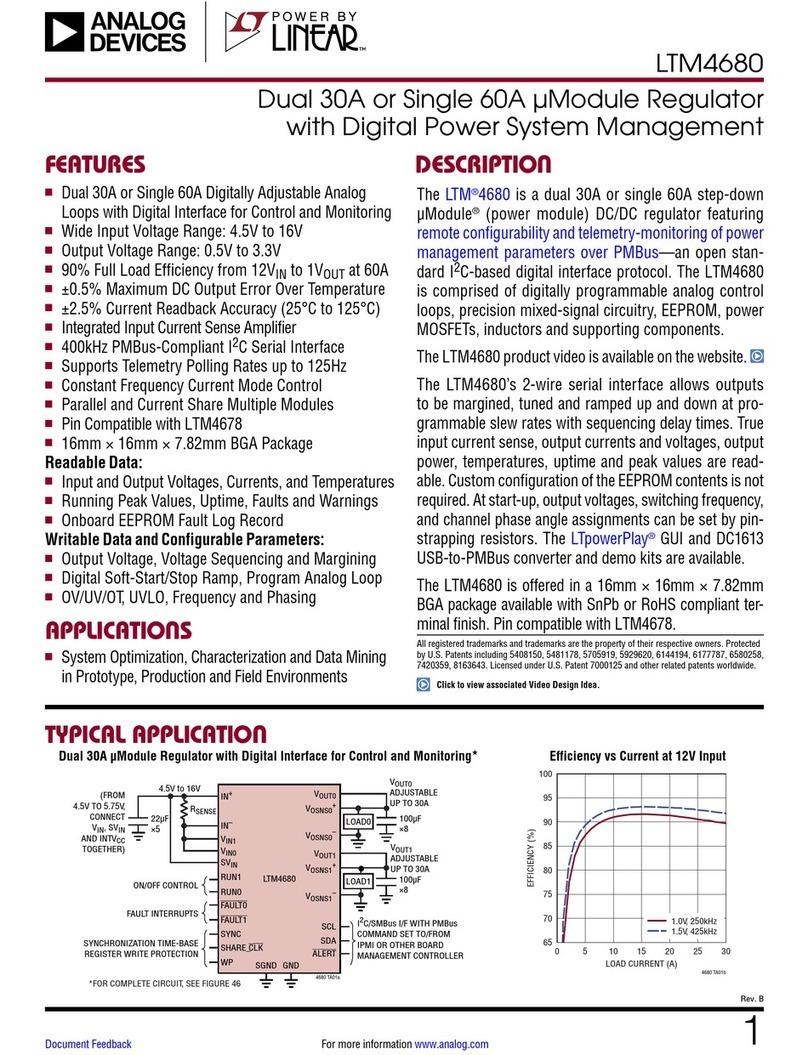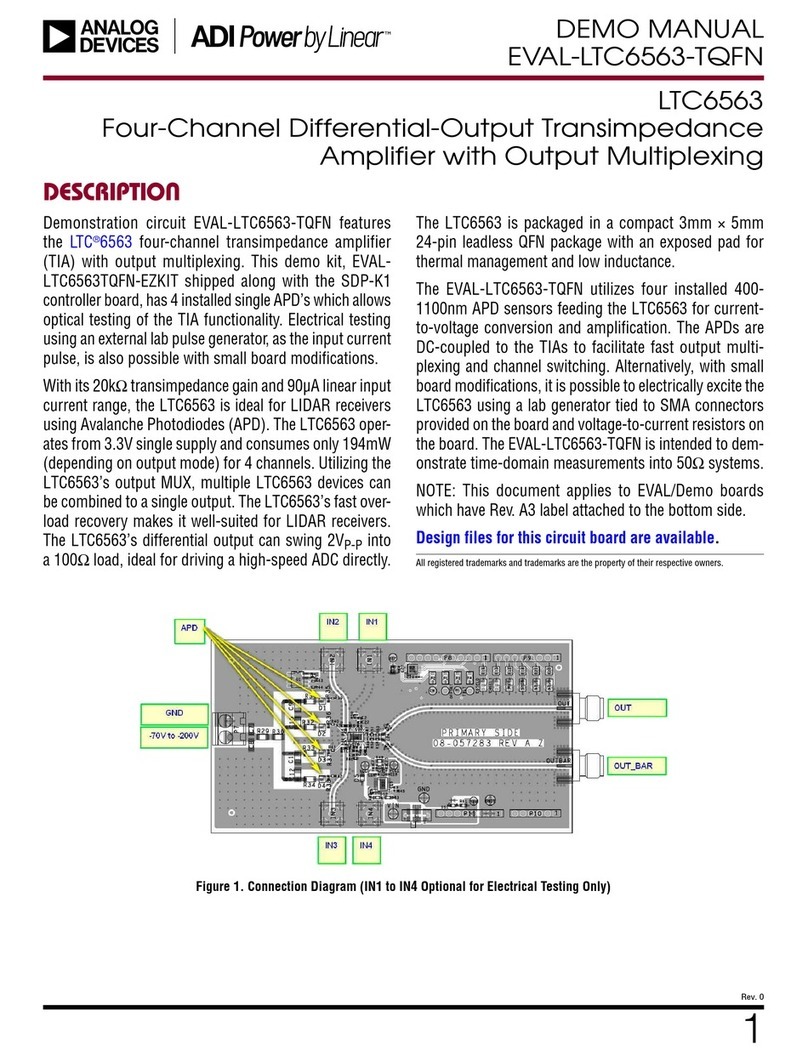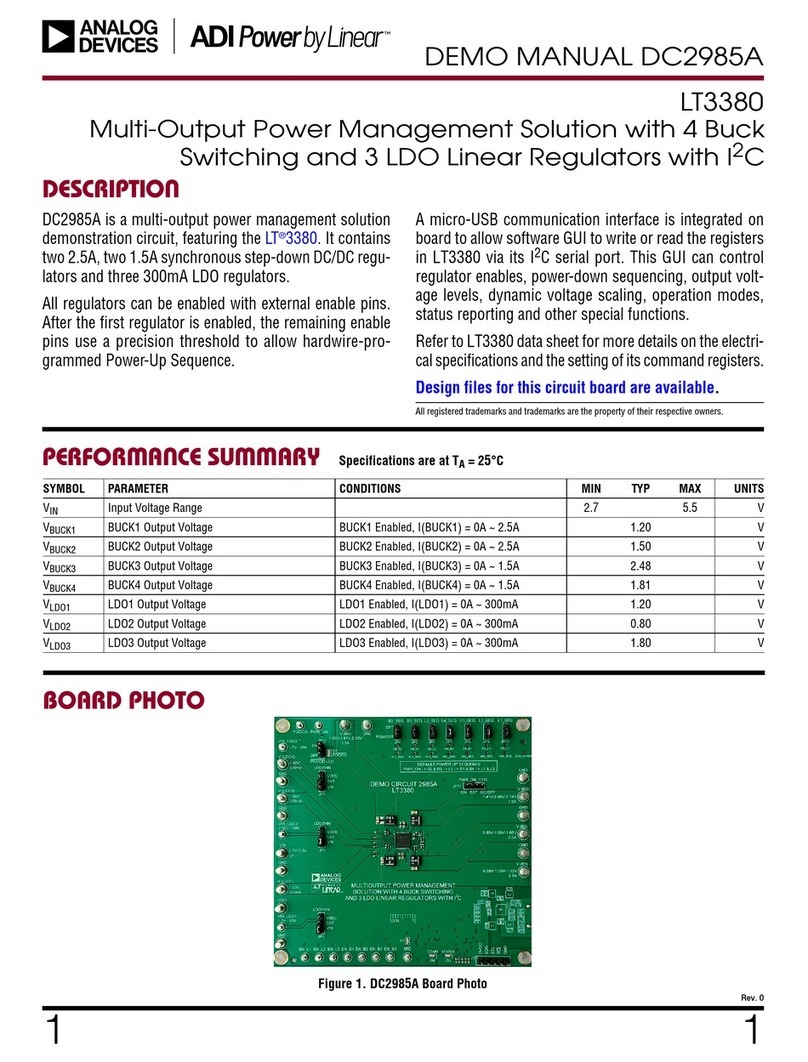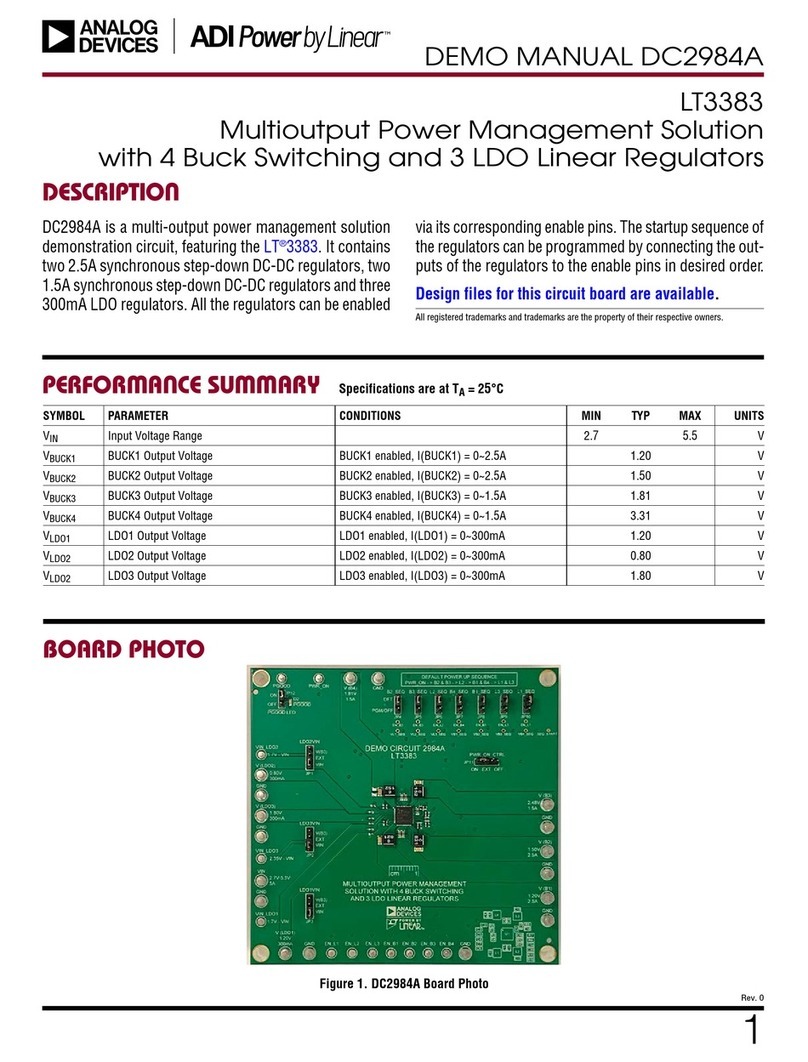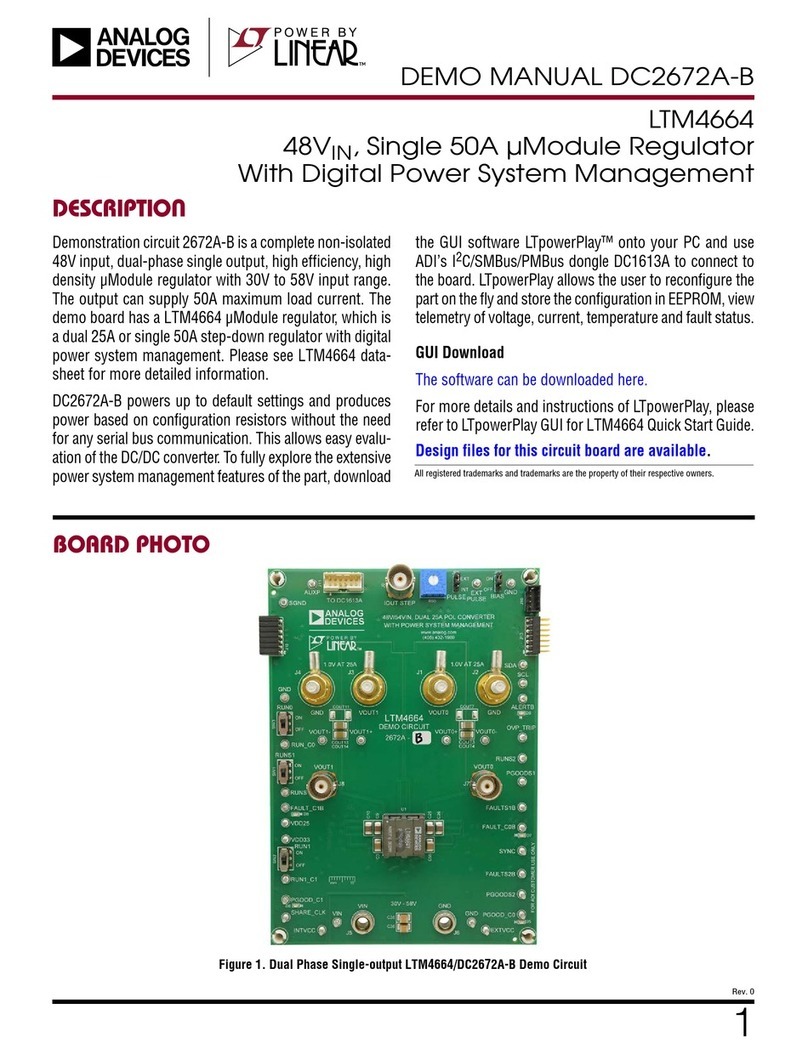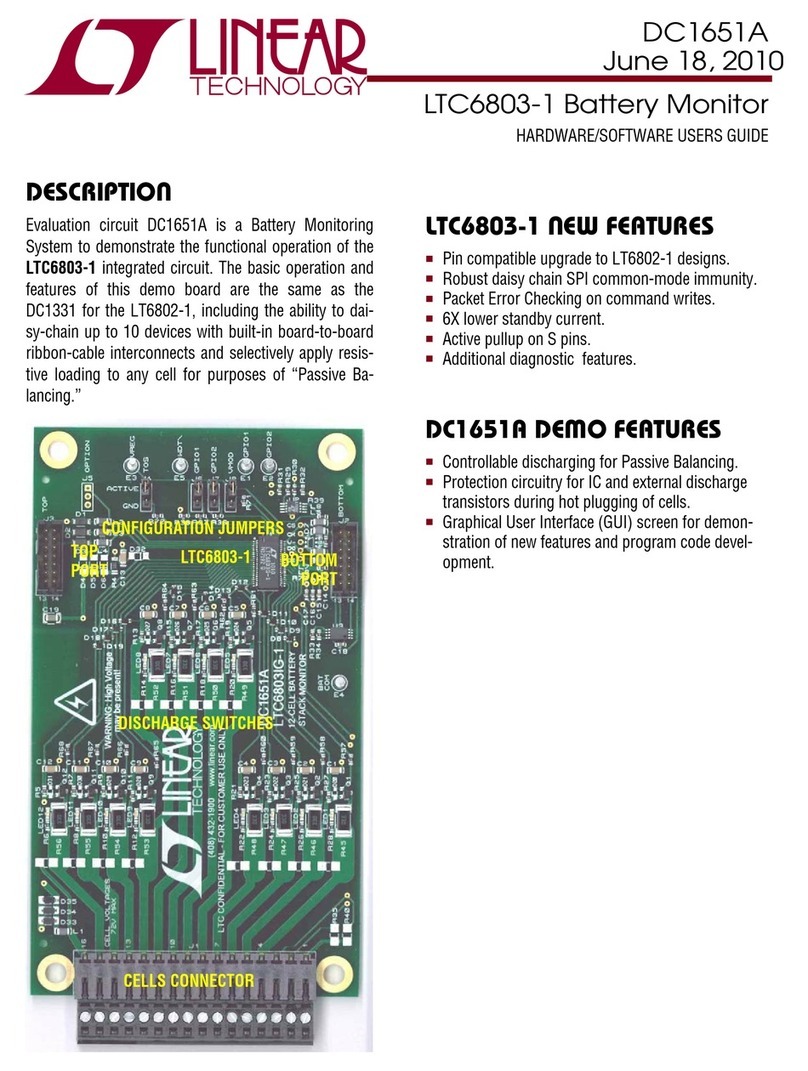
LTM4673
3
Rev. 0
For more information www.analog.com
Input Voltage Commands and Limits ......................................81
VIN_ON, VIN_OFF, VIN_OV_FAULT_LIMIT, VIN_OV_WARN_
LIMIT, VIN_UV_WARN_LIMIT and
VIN_UV_FAULT_LIMIT .......................................................81
INPUT Current and ENERGY....................................................82
Energy Measurement and Reporting..................................82
MFR_EIN ...........................................................................83
MFR_EIN_CONFIG .............................................................83
MFR_IIN_CAL_GAIN..........................................................84
MFR_IIN_CAL_GAIN_TC....................................................84
Output Voltage Commands and Limits....................................85
VOUT_MODE ......................................................................86
VOUT_COMMAND, VOUT_MAX, VOUT_MARGIN_HIGH,
VOUT_MARGIN_LOW, VOUT_OV_FAULT_LIMIT, VOUT_OV_
WARN_LIMIT, VOUT_UV_WARN_LIMIT, VOUT_UV_FAULT_
LIMIT, POWER_GOOD_ON and POWER_GOOD_OFF........86
MFR_VOUT_DISCHARGE_THRESHOLD ............................86
MFR_DAC...........................................................................86
Output Current Commands and Limits....................................87
IOUT_CAL_GAIN ................................................................87
IOUT_OC_FAULT_LIMIT, IOUT_OC_WARN_LIMIT and
IOUT_UC_FAULT_LIMIT.....................................................88
MFR_IOUT_CAL_GAIN_TC ................................................88
External Temperature Commands and Limits .........................88
OT_FAULT_LIMIT, OT_WARN_LIMIT, UT_WARN_LIMIT and
UT_FAULT_LIMIT ...............................................................89
MFR_TEMP_1_GAIN and MFR_TEMP_1_OFFSET ...................89
MFR_T_SELF_HEAT, MFR_IOUT_CAL_GAIN_TAU_INV and
MFR_IOUT_CAL_GAIN_THETA ..........................................89
Sequencing Timing Limits and Clock Sharing.........................91
TON_DELAY, TON_RISE, TON_MAX_FAULT_LIMIT and
TOFF_DELAY ......................................................................91
MFR_RESTART_DELAY .....................................................92
Clock Sharing .....................................................................92
Watchdog Timer and Power Good...........................................92
MFR_PWRGD_EN ..............................................................92
MFR_POWERGOOD_ASSERTION_DELAY.........................93
Watchdog Operation...........................................................93
MFR_WATCHDOG_T_FIRST and MFR_WATCHDOG_T ......93
Fault Responses ......................................................................94
Clearing Latched Faults......................................................94
VOUT_OV_FAULT_RESPONSE and VOUT_UV_FAULT_
RESPONSE .........................................................................94
IOUT_OC_FAULT_RESPONSE and IOUT_UC_FAULT_
RESPONSE .........................................................................95
OT_FAULT_RESPONSE, UT_FAULT_RESPONSE, VIN_OV_
FAULT_RESPONSE and VIN_UV_FAULT_RESPONSE........96
TON_MAX_FAULT_RESPONSE..........................................97
MFR_RETRY_DELAY..........................................................97
MFR_RETRY_COUNT.........................................................97
Shared External Faults ............................................................98
MFR_FAULTB0_PROPAGATE and MFR_FAULTB1_
PROPAGATE .......................................................................98
MFR_FAULTB0_RESPONSE and MFR_FAULTB1_
RESPONSE .........................................................................98
Fault Warning and Status ........................................................99
CLEAR_FAULTS .................................................................99
STATUS_BYTE..................................................................100
STATUS_WORD................................................................100
STATUS_VOUT .................................................................101
STATUS_IOUT ..................................................................101
STATUS_INPUT................................................................101
STATUS_TEMPERATURE .................................................102
STATUS_CML ...................................................................102
STATUS_MFR_SPECIFIC..................................................103
MFR_PADS.......................................................................103
MFR_COMMON................................................................104
Telemetry...............................................................................105
READ_VIN ........................................................................105
READ_IIN .........................................................................105
READ_PIN ........................................................................105
READ_VOUT .....................................................................105
READ_IOUT......................................................................106
MFR_IIN_PEAK ................................................................106
MFR_IIN_MIN ..................................................................106
MFR_PIN_PEAK...............................................................106
MFR_PIN_MIN .................................................................106
READ_TEMPERATURE_1 .................................................106
READ_TEMPERATURE_2.................................................106
READ_POUT.....................................................................106
MFR_READ_IOUT ............................................................107
MFR_IOUT_SENSE_VOLTAGE..........................................108
MFR_VIN_PEAK ...............................................................108
MFR_VOUT_PEAK............................................................108
MFR_IOUT_PEAK.............................................................108
MFR_TEMPERATURE_1_PEAK ........................................108
MFR_VIN_MIN .................................................................108
MFR_VOUT_MIN ..............................................................108
MFR_IOUT_MIN ...............................................................108
MFR_TEMPERATURE_1_MIN ..........................................109
Fault Logging.........................................................................109
Fault Log Operation..........................................................109
MFR_FAULT_LOG_STORE ...............................................109
MFR_FAULT_LOG_RESTORE...........................................109
MFR_FAULT_LOG_CLEAR ...............................................110
MFR_FAULT_LOG_STATUS .............................................110
MFR_FAULT_LOG.............................................................110
MFR_FAULT_LOG Read Example.....................................113
Identification/Information ..................................................... 117
CAPABILITY......................................................................118
PMBus_REVISION............................................................ 118
MFR_SPECIAL_ID............................................................ 118
MFR_SPECIAL_LOT.........................................................118
User Scratchpad....................................................................118
USER_DATA_00, USER_DATA_01, USER_DATA_02,
USER_DATA_03, USER_DATA_04, MFR_LTC_
RESERVED_1 and MFR_LTC_RESERVED_2....................118
Package Description .................................................119
Package Photos .......................................................122
Design Resources ....................................................122
Related Parts ..........................................................122
TABLE OF CONTENTS












